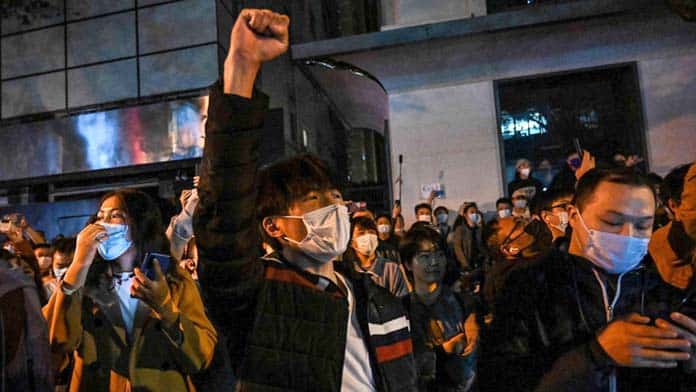China has seen the most significant nation-wide protests since the Tiananmen Square uprising in 1989, with thousands of people taking to the streets demanding an end to brutal “zero COVID” policies.
The trigger was a fire at an apartment building in Urumqi that killed ten people—with COVID lockdown measures widely blamed for preventing firefighters from arriving.
Students have protested at more than 80 universities shouting “Freedom or death”, a slogan from the 1989 struggle. Street protests also took place all across China, including in Hotan, Shanghai, Guangzhou, Wuhan and Beijing.
At the Foxconn iPhone factory in Zhengzhou hundreds of workers also clashed with riot police over fears they were being sent to work alongside people who were COVID-positive, as well as delayed bonus payments. This followed earlier protests over the closed loop production system that forced workers to continue working alongside COVID-positive workmates.
After three years of lockdowns and restrictions China’s working class and students have reached breaking point. This has brought into question the Chinese Communist Party’s (CCP) legitimacy. Many protesters are not only calling for an end to the zero COVID policy but also for an end to the regime itself.
Zero COVID
The CCP has so far avoided large numbers of COVID deaths through an elimination policy involving lockdowns, mass testing and quarantine. As a result China has the lowest COVID-19 deaths per capita worldwide. But three years of brutal COVID restrictions have seen people imprisoned in their homes, often without food.
COVID-positive patients have been crammed together in unsanitary, makeshift quarantine centres that are “worse than prisons”. Numerous people have died after being denied medical care due to lockdowns. Workers have lost months of income.
The government is using lockdowns because of its failure over vaccination and adequate health preparations. Roughly 60 per cent of those over 80, the age group most at risk, have not had a third dose, and many are not vaccinated at all.
The government has failed to increase the number of intensive care beds, with only five critical care beds per 100,000 people compared to around ten in South Korea, Thailand and Australia.
The fight for democracy
The protests have also raised political demands for democracy and an end to CCP rule.
At Tsinghua University in Beijing on 27 November, hundreds of students held up blank sheets of paper, chanting “democracy, rule of law, freedom of expression” and “long live the proletariat”.
The best hope for democracy lies in mass workers’ struggle. Workers’ strike action is the most powerful weapon in the fight for democratic change, with the power to shut down the economy and create a political crisis for the CCP that street protests alone cannot. This is how democratic rights were won in the West, as well as in countries like South Korea, Brazil and South Africa.
Western governments like those in the US and Australia are no friends of the Chinese people.
Western companies like Apple and Amazon benefit from the intense exploitation of Chinese workers under the CCP’s repressive labour laws.
If the right-wing in Australia seem sympathetic to the protests in China it is only because they want to increase Western power—and are already preparing for war with China. Any war would risk a nuclear exchange and millions of deaths in China, the US and Australia.
Beyond the limits of the West
We must also not limit our democratic vision to that of Western liberal democracy. We cannot have illusions that this will bring freedom.
There are severe limits on democracy in the West. In the US, Congress has voted to ban rail workers from striking, imposing a labour contract with no paid sick leave. In Australia, industrial action is often illegal, with risks of heavy fines.
Last week in Sydney a climate activist was sentenced to 15 months in prison for holding up traffic for 25 minutes.
Real democracy can only be won through a fight for both democratic rights and against the massive inequality in China, where 10 per cent of the population control 70 per cent of the wealth. Western-style democracy would leave power in the hands of the Chinese billionaires. It would not end the exploitation of workers and oppression of women and minorities such as Uyghurs.
The recent protests have involved students, migrant workers in Zhengzhou and Guangzhou as well as ethnic minorities such as Uyghurs in a common cause.
They are not yet on the same scale as 1989. But they have already forced the CCP to make concessions and lift some of the COVID restrictions in several cities.
Protests work. But ending the repressive rule of the CCP will require a much more powerful movement involving workers’ action on a mass scale against the authoritarian regime.
The fight for democracy needs to go beyond the kind of democracy that exists in the West. We must fight for a genuinely socialist China with the economy under workers’ democratic control.






